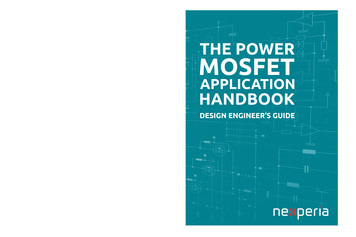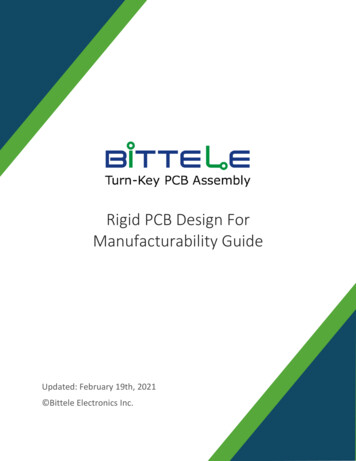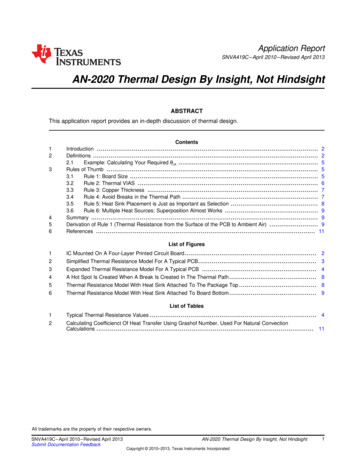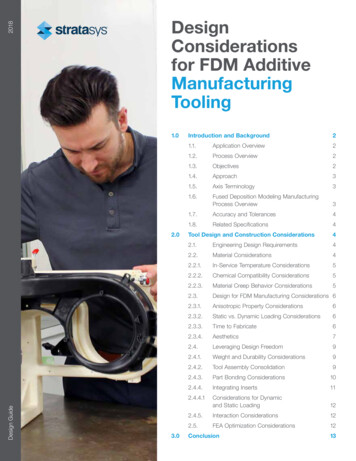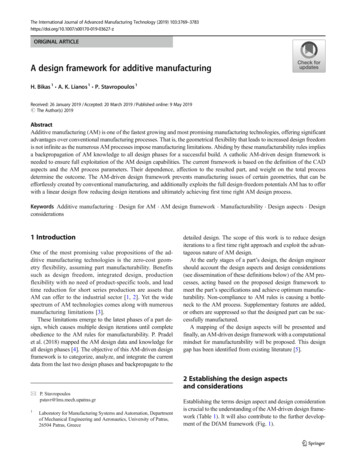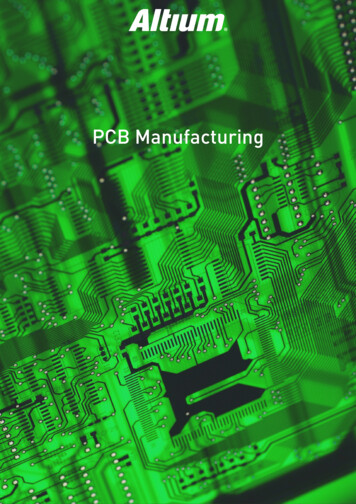
Transcription
PCB Manufacturing
PCB MANUFACTURINGPCB MANUFACTURINGPrinted circuit boards have a huge foothold in our lives. They are found in everything from our TVs and computers, to our washingmachines and watches. As a PCB designer, you understand the blood, sweat, and tears that make every board and the devices theyserve a reality. It's rare that any PCB project goes smoothly from start to finish. However, there are a number of steps you can take toincrease the efficiency and reduce the number of hiccups in the process. It is of the utmost importance that you remain vigilant anddedicated to every step of the project to ensure that your design is finished on time, on budget, and just as you had hoped.Join us as we discuss topics and tips related to the PCB manufacturing process, including:How to Prevent Silkscreen Placement Errors in PCB ManufacturingAre Fiducial Marker Placements on PCBs Still Necessary With Modern Manufacturing Capabilities?PCB Design for Manufacturing Guidelines: How to Avoid Critical Design MistakesPCB CAD Design for Manufacturing Guidelines: How Trace Routing Can Affect Solder JointsPCB Design and Fabrication Tips to Prevent Open Circuits During PCB ManufacturingHow Component Placement Can Make or Break Your Manufacturing Budgetwww.altium.com
PCB MANUFACTURINGHOW TO PREVENT SILKSCREEN PLACEMENT ERRORS IN PCBMANUFACTURINGIf you remember the 1996 Olympics then you’ll know about Kerri Strug’s strong finish. She completed her second and final vault withan injured ankle, giving the U.S. team the gold medal, and proving the importance of persevering to the end. And yet we all knowhow tempting it is to relax and let our guard down at the end of a project, even in circuit board design. One of the last things we dobefore releasing a design for fabrication is making adjustments to the board’s silkscreen images and reference designators.However, most of the time this step is not done with the same diligence as the rest of the design. This can result in the design beingrejected by the manufacturer and sent back to the designer for corrections. Let’s look at some of the potential problems with PCBsilkscreens and how designers can avoid them.Finish strong like gymnast.www.altium.com
PCB MANUFACTURINGWHAT ARE POTENTIAL PCB SILKSCREEN PROBLEMS?You're probably wondering what can go wrong, here are some of the repercussions of not making final silkscreen adjustmentsbefore sending off your design.Misrepresented components: If a silkscreen doesn’t accurately represent its intended components, it can lead to confusion for thetechnicians doing debug or modifications. This can include a shape that incorrectly represents the associated component or pinnumbers and polarity indicators that are on the wrong pins. You can imagine the sort of angst that board technicians will feel whenthey are probing for the plus side of a cap and find out that the polarity indicators are actually reversed.Un-readable silkscreen text: If the silkscreen text is unreadable it takes the board technicians more time to interpret the referencedesignators. This is often due to using too small of a font size to be legible or using the wrong linewidth size. Linewidths that are toonarrow won’t screen print on the board successfully while linewidths that are too large will balloon and become equally unreadable.Reference designators placed on wrong components: Sometimes the reference designators end up on the wrong components. Thiscan happen if a component is moved but not the reference designator, or it can be an error on the part of the designer. In any event,the board technicians trying to test the board will end up probing components that don’t match what they see in the schematic.Reference designators placed so that they are covered by assembled components: We’ve also seen plenty of examples wheresilkscreen reference designators end up under assembled parts. This is sometimes unavoidable in dense designs, but we should doour best to not let it happen. Again, picture the board technicians struggling to find “C143” on your design when the referencedesignator isn’t visible.Silkscreen ink covering metal or going into holes: Silkscreen ink that ends up covering bare metal, such as surface mount pins orplated thru-holes, can actually cause a board to be scrapped. As well, silkscreen elements that collide with other silkscreen elementsor silkscreen that end up off the edge of the board don't help anyone.WORKING WITH YOUR MANUFACTURERThe first step in avoiding these kinds of errors is to become familiar with your circuit board fabricator’s silkscreen design guidelines.They will give you information on the optimum and minimum font sizes and line widths. They will also be able to give you clearancespecifications for silkscreen to other objects, including bare metal and plated thru-holes. Establishing good communication with yourfabricator and understanding what they need before you submit a design to them is an essential key to reducing manufacturingerrors.www.altium.com
PCB MANUFACTURINGLet’s do this!WHAT CAN YOU AS A DESIGNER DO TO MINIMIZE SILKSCREEN ERRORS?Look at your design with a fresh pair of eyes, as if you were the one responsible for modifying and debugging the board. If you canview the output of your design’s silkscreen through a separate viewer it will help with this check. Can you see and read all of thereference designators? Do you have large pin-count parts marked in order to find pin 1? Do you have the correct polarity indicatedon the appropriate parts? If you can’t read and interpret the silkscreen, then be assured that your technicians won’t be able to either.Finally, use the Silkscreen DRC’s in your CAD system. Make sure to check for silkscreen over bare metal, silkscreen going into holes,and silkscreen clearances to other objects and other silkscreen elements. These checks can save you from a lot of grief.Let’s face it; designing a board can be a lot of fun. In fact, the final hand routing can be very cathartic, especially after completing achallenging place and critical route. Nevertheless, the design has to be prepared for the final output files and that can be a tediousand monotonous task. It is not uncommon for PCB designers to give silkscreen clean-up and other output related tasks less thantheir full attention because they just want to be finished with the design and move on to the next project. But like an Olympicgymnast, you have to finish strong. Want more ideas on how to finish your design with silkscreen DRC’s? Talk to an expert at Altium.www.altium.com
PCB MANUFACTURINGARE FIDUCIAL MARKER PLACEMENTS ON PCBS STILL NECESSARY WITHMODERN MANUFACTURING CAPABILITIES?About 10 years ago, I stopped watching horror movies. In my younger days I really enjoyed being scared silly, but when I started myengineering career I became more interested in action and sci-fi genres. This is likely because I was getting my fair share of horrorstories at work when simple mistakes resulted in catastrophic post-production nightmares.When I started my electronics design career, through-hole components were extremely popular and surface mounted componentswere a rare sight. When (Quad Flat Package) QFP packages of microcontrollers (MCU) became popular, I had no choice but tomigrate from the old plastic leaded chip carrier (PLCC) footprint. This is because PLCC requires an additional socket while QFP can bemounted on the PCB directly. As far as I could tell, it was only a matter of time before chip manufacturers stopped producing MCU inPLCC packages in favor of QFP or similar packages.When my PCB assembly suppliers dropped me an email stating that they were unable to machine assemble the MCU on the 200production boards I ordered, my nightmare began. Being accustomed to PLCC sockets, which are through hole components, it didn’toccur to me to provide fiducial markers on the PCB. Failing to do so meant all the QFP packaged MCUs with tiny pitches had to bemanually assembled.This resulted in a higher percentage of boards being rejected and countless hours spent fixing faults from imperfect manualsoldering. Since then, I make a point of always using fiducial markers in my designs, even if my suppliers tell me that they havewww.altium.com
PCB MANUFACTURINGupgraded their machines to work without the markers.You could end up with a complete mess if you omit fiducial markers.WHAT IS A FIDUCIAL MARKER AND HOW DOES IT HELP IN MANUFACTURINGIn PCB design, a fiducial marker is a rounded shape of copper that acts as a reference point for pick and place assembly machines.Fiducial markers help machines recognize the orientation of the PCB and its surface mount components with packages that have tinypitches like Quad Flat Package (QFP), Ball Grid Arrays (BGAs) or Quad Flat No-Lead (QFN).There are two types of fiducial markers commonly found in PCB designs: global fiducial markers and local fiducial markers. Globalfiducial markers are a copper reference placed on the edge of the PCB that allows the machine to determine the orientation of theboard with respect to the X-Y axis. Placement machines also use the fiducial marker to compensate for any skew when the PCB isclamped.Local fiducial markers are copper markers that are placed outside of the corner of a quad packaged surface mount component. It isused by assembly machines to precisely locate the footprint of a component and reduces errors in component placement. This isespecially important when you have fine pitched and large quad packaged components in your design.www.altium.com
PCB MANUFACTURINGAlways check with your manufacturer for fiducial marker requirements.ARE FIDUCIAL MARKERS NECESSARY WITH MODERN MANUFACTURING TECHNOLOGY?I have always designed my PCBs with both global and local fiducial markers. However, when I came across an article that explainedthe possibility about omitting local fiducials, I was intrigued. It made sense to remove fiducial markers on smaller PCBs to maximizespace for signal traces.As a result of advancements in manufacturing technology, local fiducial markers can be omitted under certain conditions. On smallerboards, modern assembly machines can place SMT components using only global fiducials. Fiducial markers may also be omitted forcomponents that have a larger pitch. For example, surface mount components with pitches above 1.0mm and above can be placedaccurately by the latest machines.That being said, it is important to discuss the extent of your manufacturer’s machine’s capabilities before removing local fiducialmarkers in your design. I’ve learned the hard way that not all manufacturers are equipped with machines that are powered by thelatest technology. On the other hand, global fiducial markers should never be omitted from your designs. Even if you are workingwith some of the most advanced manufacturing capabilities.BEST PRACTICES FOR USING FIDUCIAL MARKERS IN PCB DESIGNIf you want to get the best out of machine assembly, you need to get your fiducial markers right. There are few important guidelineswhen it comes to placing fiducial marker in your design.1. The fiducial marker is made by placing a non-drilled copper layer in a circular shape. The fiducial marker must be free fromsolder mask.www.altium.com
PCB MANUFACTURING2. The optimum size of a fiducial marker should be between 1mm and 3mm. A clearance area similar to the diameter of themarker must be maintained.3. For global fiducials, 3 markers are placed on the edge of the boards for the best accuracy. In cases where there is insufficientspace, at least 1 global fiducial marker is required.4. The fiducial marker must maintain a distance of 0.3 inches to the edge of the board, excluding the clearance area of thefiducial marker.5. For local fiducial, place at least two fiducial markers diagonally on the outside edge of the surface mounted component.Using professional PCB design software, a fiducial marker can be placed by inserting a pad, changing the pad size to zero, and settingthe correct values for the diameter. Need more tips in placing fiducial markers on your design? Contact an expert at Altium.www.altium.com
PCB MANUFACTURINGPCB DESIGN FOR MANUFACTURING GUIDELINES: HOW TO AVOIDCRITICAL DESIGN MISTAKESI swear I would have been on the journey to be the next MasterChef if I had not completed my engineering degree. Not because I’mterrifically good at cooking, but because I didn’t give up after a horrifying attempt to cook fried rice vermicelli. Failing to soak thoselong threads of noodles resulted in pasta with a hard wire texture that was beyond salvageable. This was a good example of whatcan happen to a dish when you don’t follow directions carefully.Like in cooking, mistakes are bound to happen in electronics design, even for the most meticulous designers. But some mistakes arecritical enough that you will have to scrap the entire printed circuit board (PCB) and start over. When you’re patiently waiting for aprototype PCB to test your circuits, this can spell costly delays in the product development cycle.CRITICAL DESIGN MISTAKES IN PCB MANUFACTURINGWe all hate to make mistakes. But in reality, it takes two or three tries to get the perfect design. As long as we fix mistakes in the earlydesigns by simply cutting off tracks or jumper wires, the impact on the development process is minimal. The same can’t be saidabout some of the following mistakes that almost always ruin your PCBs.www.altium.com
PCB MANUFACTURING1. Using the Wrong FootprintWhile most passive components are available in both through-hole and surface-mounted form factors, integrated circuits (ICs),especially special function ICs, are produced in only a few package types. Confusing a Small Outline Integrated Circuit (SOIC) and aShrink Small Outline Package (SSOP) may result in trying to fit a smaller IC on a larger footprint, or vice versa.Remember to verify the package type of your components by thoroughly checking their datasheets. Don’t make assumptions andensure that both the dimensions of the IC and its pitch size are correct. I learned my lesson when I mistakenly used the ‘narrow’version of a SOIC since the ‘wide’ version had the same pitch size.Use the correct IC components to avoid design errors that will affect the design footprint.2. Misaligning the Address BusDuring my early years as a designer, high-density memory requirements meant using parallel Flash memory or Static Random AccessMemory (SRAM). I had to deal with up to 23 bits of address and 8 bits of data signals. A mistake in matching the address pins of themicrocontroller to the memory components could result in an unusable prototype or spending a couple of days cutting off andrewiring the signals with jumper wires. To avoid this, I had to fully understand the addressing bus of the microprocessor and howeach memory chip should be connected.3. Bad Ground Plane DesignThe effect of a proper ground plane design may not be obvious in simple digital circuits. But you may have a batch of populated, butunacceptable PCBs if you ignore the ground plane best practices for analog or mixed circuit designs. This can cause interference andcross-talk, making it necessary to quickly produce a better design.While I’m lucky enough to have salvaged PCBs with bad ground connections, I now ensure that future designs adhere to properground plane designs. Remember to separate analog and digital grounds by a single point when it is appropriate and consider thewww.altium.com
PCB MANUFACTURINGcurrent flow path.4. Incorrect Mounting HolesMounting holes can be helpful for reducing electromagnetic interference (EMI). However, if your mounting hole coordinates are offthen your well functioning board will not be secured to its casing. Make sure that your coordinates are exact, otherwise there mightnot be a clear path for to secure your screw.For designs where the PCB is mounted to an enclosure, it is vital to start the PCB layout with the mounting holes placed on the rightcoordinate before populating other components.Drilling won’t help when you get the hole position wrong in the first place.5. Excessive Current Density On Thin CopperWhat could go wrong when you’ve covered all your bases by performing power budget calculations at a subcircuit level? A commonmistake is failing to consider the total current passing through the primary voltage signal track. Another common mistake is failing toprovide adequate copper width. These mistakes can result in overheating or, in certain cases, for the conducting copper to totallybreak apart. The right power budget analysis should give you a clear indication of the required track width. If you’re working withprofessional PCB design software, like Altium Designer, you can take advantage of DC drop analysis tools to verify your calculation.www.altium.com
PCB MANUFACTURINGPCB CAD DESIGN FOR MANUFACTURING GUIDELINES: HOW TRACEROUTING CAN AFFECT SOLDER JOINTSEditorial credit: Aija Lehtonen / Shutterstock.comA couple of weeks ago I attended a concert that was a tribute to the big band leader Stan Kenton. I love big band jazz for manyreasons, one of which is the configuration of musicians and instruments in the band. There are usually around 15 to 20 musicians ondifferent instruments, and everyone plays a different part. If just one person makes a mistake, it can ruin the balance of the numberthat was so carefully arranged by the composer.The importance of each member of the band playing harmoniously together reminded me of the importance of a correctlymanufactured printed circuit board. If just one part isn’t soldered correctly, the finished circuit board may have intermittent failures,or perhaps not work at all. Just as a saxophone playing a sour note can ruin the whole number, a bad solder joint can ruin the entireboard. Fortunately, design for manufacturing (DFM) rules can help you to avoid hitting sour solder joints on your circuit board.One area where DFM rules can help your board may come as a surprise. How you route traces on your PCB can have a direct effecton solder problems, and DFM rules offer some guidance there. Take a look with me now at how trace routing can cause problemslike cold solder joints or tombstoning so that you will know what to avoid in the future.www.altium.com
PCB MANUFACTURINGACUTE ANGLE TRACESThe first problem that we’ll look at is acute angle traces. Although this situation doesn’t specifically lead to a solder problem, it is arouting problem noted in PCB DFM guidelines.Acute angles in traces are traces which have corners that are greater than 90 degrees. This causes the trace to come back on itself.The wedge that is created by the acute trace angle can trap acidic chemicals during the fabrication process. These trapped chemicalsdon’t always get cleaned up as they should during the cleaning phase of fabrication and will further eat away at the trace. This caneventually result in the trace breaking or cause intermittent connections.Trace routing on a PCBTOMBSTONING PARTS DUE TO TRACE WIDTHSTombstoning happens when a small two pin part, such as a surface mount resistor, stands up on end on one of its pads duringsoldering. This results from a heating imbalance between the two pads during solder reflow. Whichever side melts first pulls the parttowards that side, and causes the tombstoning effect.One of the factors that can cause this heating imbalance is using different sized traces on the two pads. The wider the trace, thelonger it will take for the pad that it is connected to heat up. If one pad of the part has a very narrow trace, and the other pad has avery wide trace, you will likely have a solder reflow imbalance and one pad will melt and reflow before the other one.Often electrical engineering will want a power trace that is too wide for the manufacturer to reliably solder. PCB design formanufacturing guidelines have recommendations for the minimum and maximum trace widths to use on different sized parts, butthat might not solve your problem. The key for you is to balance the requirements of both electrical engineering and manufacturingwww.altium.com
PCB MANUFACTURINGand come to a common agreement between the two. In this way, you can meet the needs of both sides on your design.DFM rules can help you to design out manufacturing problems on your board.COLD SOLDER JOINTSAnother problem that can happen when routing thicker traces is the creation of a cold solder joint. A cold solder joint is one wherethe solder has not reflowed correctly to make a good connection, or that the solder has pulled away from the connection. Whenrouting a thick trace out of a pad, the thick trace size may end up pulling the solder off of the pad where it is needed to make theconnection to the part.The solution is to use traces widths that are smaller than the pad size. Some DFM guidelines recommend a trace no wider than0.010 mils, although this again must be worked out to balance the needs of both electrical and mechanical engineering.There is a lot more to PCB design for manufacturing guidelines than the trace routing recommendations that we have given youhere. DFM guidelines will also help you with proper component placement techniques, footprint sizes, and other aspects of yourdesign. This will ultimately help your design to be manufactured with as few errors as possible. A circuit board that is error freeduring manufacturing is a reflection of a good and solid design, kind of like hearing the Stan Kenton band playing an error-freerendition of Intermission.PCB design software, like Altium Designer, has advanced routing capabilities and other features to better help you to designaccording to your DFM rules. This will help you to deliver a design that is DFM compliant to your manufacturer the first time.Would you like to find out more about how Altium can help you with your next design to assure its DFM compliance? Talk to anexpert at Altium.www.altium.com
PCB MANUFACTURINGPCB DESIGN AND FABRICATION TIPS TO PREVENT OPEN CIRCUITSDURING PCB MANUFACTURINGFor a couple years, I lived in a town with a chocolate and candy factory. It was an amazing and terrible time, because you could go tothe factory and buy “seconds,” or substandard candies, for about 75% off the normal price. Usually, the mistake was cosmetic, likethe chocolate cracking over the caramel, and everything tasted totally fine.When a PCB manufacturer makes a mistake, sometimes it’s cosmetic, and the board will still function. Something like misaligning thefinal screen printing probably won’t affect the electrical performance, but a similar misalignment of a solder mask or copper layercould completely ruin your board. Since PCBs are intended to route electricity, most of the significant performance defects areelectrical in nature, things like open circuits, shorts, and routing or material failures.Depending on your source, open circuits constitute about a third of PCB defects, especially in the form of open solder joints. Anumber of issues can cause open circuits on your board, varying from materials to processing to handling. Here are the mostcommon causes.www.altium.com
PCB MANUFACTURINGSOLDER PASTEIf solder paste is applied inconsistently, either varying with the amount deposited or with some locations being missed entirely, thenthere won’t be enough to form a solid joint. You might be left with an open circuit, or a joint that’s weak and prone to breakage.Another issue with solder paste is inconsistent reflow temperatures across the surface. If you’ve ever microwaved chocolate, you’veprobably seen hot spots that melt much sooner than the rest. The same kind of variability can happen during solder reflow. If someareas don’t reach reflow temperature and bond completely, the electrical connection won’t form, similar to leaving unmelted chunksof chocolate in your cocoa or frosting mix.When solder paste is applied, if the aspect ratio (the aperture width to stencil thickness) is off, and you’re more likely to see issueswith solder paste deposits. Make sure to verify the layer thickness, especially of your solder mask, with your manufacturer.Like melting chocolate, solder must reach reflow temperatures everywhere on your board.CONTAMINATIONNo one wants to eat contaminated chocolate. PCB components can get contaminated, too. Environmental contamination can comefrom a variety of sources, either on the board or in the solder paste. Obvious causes are chemical spills, dust and particulates in theair, and oils from being touched.Even moisture in the air can lead to accelerated corrosion. Any contamination or corrosion of the pad surface or the componentlead can keep the solder joint from bonding correctly. Check for quality controls from your manufacturer and use in-house handlingto make sure parts stay clean and undamaged.www.altium.com
PCB MANUFACTURINGFingerprints on a board are a common source of contamination, often leading to corrosion and poor solder joints.GAPS AND CRACKSGaps caused by surface irregularities can cause areas of the PCB to lose planarity, making the distance between different leads onthe same component vary widely, and keeping leads from even making contact with solder paste during reflow. This is most commonif you have component warping or solder mask irregularities, but can result from other thermal mismatch issues, problems in thelayer stack up (like air bubbles from improper outgassing), or physically mishandling the board.Sometimes gaps and cracks are severe enough to be visible, but most often you’ll need to use a microscope or X-ray to find issues,especially with smaller packaging on components. Depending on the budget that you have for troubleshooting, you may have to useelectrical testing to identify the location of the open circuit and have your manufacturer or a test lab do the final root cause analysis.Something as simple as dropping your board can break solder connections especially if they were fragile to begin with, like achocolate egg!www.altium.com
PCB MANUFACTURINGMistakes during fabrication can be time-consuming and costly. You can improve the process by managing your designs andmanufacturer information with quality design layout software, like Altium Designer and Altium Vault. Do you want to learn moreabout how Alitum’s capabilities can help you improve your design and manufacturing process?Talk to an Altium PCB design expert.www.altium.com
PCB MANUFACTURINGHOW COMPONENT PLACEMENT CAN MAKE OR BREAK YOURMANUFACTURING BUDGETWith each new PCB design, there comes a time when you must make decisions based on more than performance alone. Physicalspace is easily overlooked in the world of equations, schematics, and oscilloscopes—we'll often focus on signal integrity over suchmundanities as component volume. In the days of room-filling computers, we didn’t have to be deliberate with our space. However,cost, time and space requirements have obviously changed. There is now a point in every designer’s journey where the reality oftheir budget (or lack thereof) smacks them square in the face, and we must turn to assessing the cost implications of ourdecisions—particularly how our board layout affects manufacturing costs. We've come a long way in both scalability of componentsand our knowledge of component placement. Learning from our mistakes, we can identify some key areas that can help keep yourdesign to a more budget-friendly range.WHAT CAUSES MANUFACTURING COSTS TO SKYROCKET?With the technology available to factories, it might seem like anything is possible on a small budget. While this might mostly hold true,each step added in the manufacturing process is a step that will certainly be billed. The idea of a simplistic design should always bein the back of your head, since manufacturers will look to charge for any extra work they must do. This includes rapid pick and placemachines placing the components on the board, machine-guided soldering steps, flipping of the board, factory worker touch times,www.altium.com
PCB MANUFACTURINGand so on. The more they have to finagle with your board, the greater the cost to you.AVOID SPACE-RELATED MANUFACTURING BUDGET PITFALLSThere are hundreds of tips and tricks that you will undoubtedly encounter and learn from throughout your design. However, thefollowing three tactics are your low-hanging, budget-friendly fruit that you should always keep in mind.Extra steps in the manufacturing of your PCB design will add costs.Organization of Your Board. With the varied technology in mounting components these days, we'll likely find ourselves mixingand matching through-hole with surface-mount components. This poses a slight issue for manufacturers, as there are uniqueways to install and solder each component to the PCB. This will certainly add a plethora of additional steps and touch timerequired to produce the board—thus adding more cost to your overall manufacturing budget. If keeping to one mountingtechnology is out of the design question, then grouping similarly mounted components together on either side of the boardwill limit the number of steps taken to solder such groups successfully.Orientation of Individual Components. Throughout your life, you may have been told to keep your ducks in a row. Regardlessof how you've kept your ducks (or other poultry) over all these years, I must bring you back the same old adage in regards toyour PCB design. Keeping components scattered all over the board isn't a wrong practice, but your manufacturing costs willsoar to new heights. Keeping your components oriented with each other and in a nice neat row will decrease the amount oftime spent on soldering as well as minimize errors and extra steps needed in manufacturing.Keeping Components on the Topside of the Board. When working with a simplistic two layer board, we suggest keeping yourcomponents on the top side of the board. Depending on your physical limitations, you may be thinking to yourself "He
PCB Design for Manufacturing Guidelines: How to Avoid Critical Design Mistakes PCB CAD Design for Manufacturing Guidelines: How Trace Routing Can Affect Solder Joints PCB Design and Fabrication Tips to Prevent Open Circuits During PCB Manufacturing How Component Placement Can
